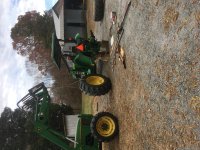We want them farther out, a LOT farther out.
It happens to be a Kubota and our ASSUMPTION is that the wheels are set to minimum spacing for reasons of shipping.
OK, so we could have the dealer do it, but that would be expensive.
We could get it there, but once the tires are OUT it would be too wide to fit between the fenders of the only trailer we have that is big enough (not a bed over).
The tractor in question does NOT have a back hoe, or we would use that to hold it up.
If we are to maintain tread direction we will have to swap side to side and of course that means having both rear wheels off at the same time.
16.9 x 28 - filled with about 650 lbs of liquid ballast (each).
The biggest problem we foresee if we do this ourselves is lining up the wheel studs.
One possibility for moving them around is an engine crane, another is pallet forks on a second tractor, we have both.
So, we are looking for ideas on how to get the wheels lined up clock/counter-clock wise.
If only our pallet forks had rollers in place of tines<grin>
It happens to be a Kubota and our ASSUMPTION is that the wheels are set to minimum spacing for reasons of shipping.
OK, so we could have the dealer do it, but that would be expensive.
We could get it there, but once the tires are OUT it would be too wide to fit between the fenders of the only trailer we have that is big enough (not a bed over).
The tractor in question does NOT have a back hoe, or we would use that to hold it up.
If we are to maintain tread direction we will have to swap side to side and of course that means having both rear wheels off at the same time.
16.9 x 28 - filled with about 650 lbs of liquid ballast (each).
The biggest problem we foresee if we do this ourselves is lining up the wheel studs.
One possibility for moving them around is an engine crane, another is pallet forks on a second tractor, we have both.
So, we are looking for ideas on how to get the wheels lined up clock/counter-clock wise.
If only our pallet forks had rollers in place of tines<grin>


